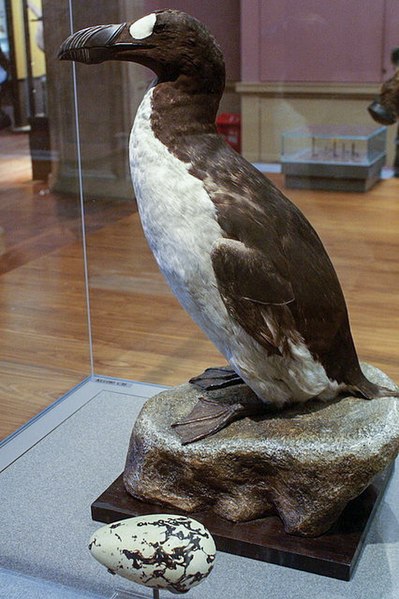Mynd:Great Auk (Pinguinis impennis) specimen, Kelvingrove, Glasgow - geograph.org.uk - 1108249.jpg

Stødd av hesi forskoðan: 399 × 599 pixels. Aðrar upploysnir: 160 × 240 pixels | 426 × 640 pixels.
Upprunafíla (426 × 640 pixel, stødd fílu: 271 KB, MIME-slag: image/jpeg)
Søgan hjá fíluni
Trýst á dato/tíð fyri at síggja fíluna, sum hon sá út tá.
| Dagur/Tíð | Lítil mynd | Dimensjónir | Brúkari | Viðmerking | |
|---|---|---|---|---|---|
| streymur | 11. aug 2017 kl. 09:26 |  | 426 × 640 (271 KB) | Archaeodontosaurus | Corrections |
| 24. feb 2011 kl. 17:46 |  | 426 × 640 (78 KB) | GeographBot | == {{int:filedesc}} == {{Information |description={{en|1=Great Auk (Pinguinis impennis) specimen, Kelvingrove, Glasgow A lost part of the biogeography of Britain, and the only flightless bird that has bred in Europe in historical times. The last Great Auk |
Myndarslóðir
Hesar síður slóða til hesa mynd:
Alheims fílunýtsla
Aðrar wkiir brúka hesa fílu:
- Nýtsla á ar.wikipedia.org
- Nýtsla á arz.wikipedia.org
- Nýtsla á ast.wikipedia.org
- Nýtsla á as.wikipedia.org
- Nýtsla á az.wikipedia.org
- Nýtsla á bg.wikipedia.org
- Nýtsla á bn.wikibooks.org
- Nýtsla á ca.wikipedia.org
- Nýtsla á da.wikipedia.org
- Nýtsla á de.wikipedia.org
- Nýtsla á en.wikipedia.org
- Nýtsla á en.wikibooks.org
- Nýtsla á en.wiktionary.org
- Nýtsla á es.wikipedia.org
- Nýtsla á et.wikipedia.org
- Nýtsla á eu.wikipedia.org
- Nýtsla á fa.wikipedia.org
- Nýtsla á fi.wiktionary.org
- Nýtsla á fr.wikipedia.org
- Nýtsla á fy.wikipedia.org
- Nýtsla á ga.wikipedia.org
- Nýtsla á gd.wikipedia.org
- Nýtsla á gl.wikipedia.org
- Nýtsla á he.wikipedia.org
- Nýtsla á ia.wikipedia.org
- Nýtsla á it.wikipedia.org
- Nýtsla á ja.wiktionary.org
- Nýtsla á jv.wikipedia.org
- Nýtsla á la.wikipedia.org
- Nýtsla á lv.wikipedia.org
- Nýtsla á ml.wikipedia.org
- Nýtsla á mrj.wikipedia.org
- Nýtsla á no.wikipedia.org
Vís meiri globala nýtslu av hesi fílu.
